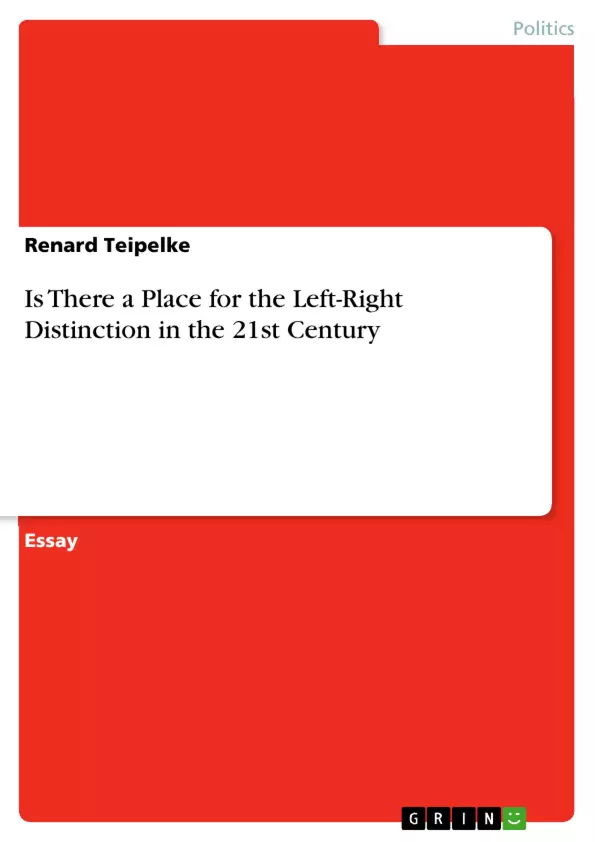You can stand in front of a McDonald’s restaurant and see a variety of burgers, ice cream, French fries, nuggets, coffee, milk shakes, soft drinks and so on. With all of this food, you can create a very tasty meal. For example, if you are dissatisfied with the cheeseburger, you can ask for a cheeseburger without pickles, or perhaps add a side of fries or nuggets to compliment your burger. These meals have hundreds of variations and the same counts for the political spectrum in Germany. You choose meal No. 1 “CDU” and you can differentiate between a conservative, liberal, or social burger. You can take a religious or atheistic milk shake, and authoritarian or libertarian French fries. In short, concerning German political parties which do not stand for extremist programs, you can find each coloration in nearly every party.
Inhaltsverzeichnis (Table of Contents)
- Is There a Place for the Left/Right Distinction in the 21st Century?
- The Left/Right Distinction: A Historical Perspective
- The Median Voter Theorem and Party Platforms
- The Blending of Left and Right Ideologies
- The Enduring Influence of the Left/Right Distinction
- Beyond the Left/Right Dichotomy: A Call for Programmatic Discussions
Zielsetzung und Themenschwerpunkte (Objectives and Key Themes)
This text aims to explore the relevance of the left/right distinction in contemporary German politics, examining its historical roots and its application in the current political landscape. The author argues that the left/right dichotomy, while still prevalent in discourse, fails to adequately reflect the complexity of modern party platforms and policy agendas.
- The historical development of the left/right distinction in Europe
- The application of the left/right distinction in the German political system
- The limitations of the left/right dichotomy in capturing the nuances of modern political parties
- The importance of programmatic discussions over simplistic left/right labeling
- The influence of the left/right distinction on public opinion and political discourse
Zusammenfassung der Kapitel (Chapter Summaries)
- This introductory chapter establishes the main argument: while the left/right distinction is deeply embedded in German political discourse, it fails to accurately reflect the complexity of modern political parties and policies. The chapter uses the analogy of a McDonald's menu to illustrate how political parties offer a range of options, blurring the lines between traditional left and right positions.
- This chapter explores the historical development of the left/right distinction, tracing its origins back to the French Revolution and its spread throughout Europe. The chapter also discusses the traditional terms and characteristics associated with the left and right in European politics.
- This chapter examines the median voter theorem and its implications for party platforms. It argues that parties have to cater to the median voter, leading to a blurring of traditional left and right ideologies. This chapter also analyzes the internal divisions within major German parties, showcasing the complexity of their policy positions.
- This chapter explores how the traditional left/right distinction has become less relevant in contemporary German politics due to the convergence of policies and the emergence of "catch-all" parties. It highlights the challenges of applying traditional labels to parties that address diverse policy fields and engage in compromise.
- This chapter examines the enduring influence of the left/right distinction despite its limitations. It argues that the labeling continues to shape public opinion, political discourse, and even the success or failure of certain politicians and initiatives. The chapter also discusses how the left/right dichotomy can be used to simplify complex issues and create prejudiced opinions.
- This concluding chapter emphasizes the need to move beyond the left/right dichotomy and engage in programmatic discussions based on specific political views, approaches, and propositions. The chapter advocates for a more nuanced and informed political discourse that avoids simplistic labeling and fosters greater understanding of diverse policy positions.
Schlüsselwörter (Keywords)
This text focuses on the left/right distinction, its historical development, and its application in contemporary German politics. It examines the limitations of the left/right dichotomy, emphasizing the need for programmatic discussions that move beyond simplistic labels. Key terms include: left/right distinction, political spectrum, German politics, median voter theorem, party platforms, policy agendas, programmatic discussions, public opinion, political discourse.
- Quote paper
- Renard Teipelke (Author), 2007, Is There a Place for the Left-Right Distinction in the 21st Century, Munich, GRIN Verlag, https://www.grin.com/document/141677



